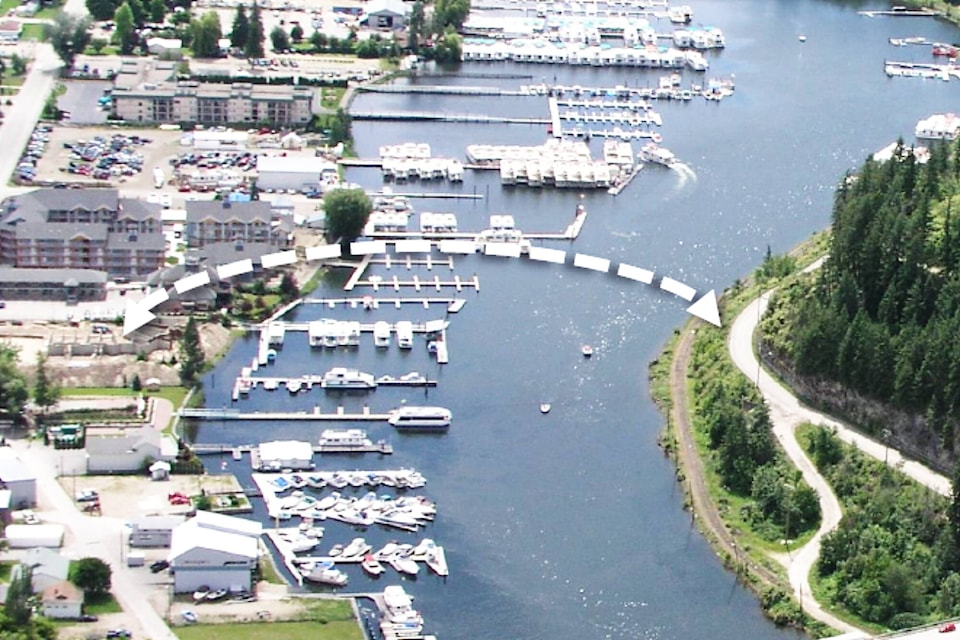The District of Sicamous has received $50,000 in federal funding to determine what steps need to be taken to construct a new pedestrian bridge across Sicamous Narrows.
On Wednesday, March 1, the district announced the money had been awarded from the federal Active Transportation Fund for the completion of a feasibility study for an active transportation bridge.
“Council is very excited about the feasibility study that will help us navigate our future active transportation. This will be a great project for all of us to be proud of,” commented Mayor Colleen Anderson in a media release. “A pedestrian bridge would be an amazing attraction for Sicamous tourism and enable all residents to connect to the west side of the narrows, enjoy the views, and access the new rail trail. This is inclusive of our live more, live well strategy.”
The bridge, for pedestrians, cyclists and other active transportation users, would provide a direct link between the town centre and communities located west of the Sicamous Narrows, as well as to the future Shuswap North Okanagan Rail Trail, reads the media release.
The study will consider Sicamous’ draft Active Transportation Network Plan, capital plans and previous community engagement, said the district. Key considerations of the feasibility report will include civil and structural engineering capabilities, as well as the environmental and archaeological implications of the project. District staff, Urban Systems and COWI North America, a structural engineering sub-consultant, will collaborate to create the final feasibility report.
“Supporting the feasibility study for the Sicamous Narrows bridge crossing will help us determine how we can make travel in the District easier, more convenient, and safe,” said International Development Minister Harjit S. Sajjan. “This research will bring us one step closer to connecting two vital sections of the District for everyone’s enjoyment, and will promote the vibrant, healthy quality of life Sicamous embraces.”
The bridge would go at the end of Main Street, where a former bridge for vehicle traffic once stood.
Read more: Two bridges recommended to replace Sicamous Bruhn Bridge on Highway 1
Read more: Single-bridge option chosen to replace RW Bruhn Bridge
Read more: VIDEO: New Sicamous Highway 1 bridge renderings show one less lane than promised
A government document made public early on in the Bruhn Bridge replacement process showed three options, including a four-lane structure accompanied by a second bridge at Main Street. This, according to the Ministry of Transportation and Infrastructure (MOTI), was the preferred option of Sicamous council and First Nations. In 2018, after the process opened to public consultation, it was determined a five-lane bridge would replace the current two-lane Highway 1 structure over the Narrows, without the second bridge at Main Street.
In 2021, a new, four-lane design for the Bruhn Bridge’s replacement was revealed by the Ministry of Transportation and Infrastructure. The ministry said this was selected because it would allow for the closure of the Old Spallumcheen Road intersection at the west end of the existing bridge. The ministry said reducing the bridge from five lanes to four would reduce the impact of the project on areas identified as culturally or archaeologically sensitive, and allow the existing bridge to remain in service during construction of the new span.
After the decision was made to construct a single bridge, Sicamous council began expressing interest in a pedestrian bridge over the channel. In 2021, then Mayor Terry Rysz said the province had referred the district to the active transportation grant program. He estimated a suspension bridge would cost more than $5 million, and said it would be an essential link to the proposed Sicamous to Armstrong rail trail.
The federal government says the Active Transportation Fund will provide $400 million over five years “to make travel by active transportation easier, safer, more convenient and more enjoyable, in support of Canada’s first National Active Transportation Strategy.”
Responding to concerns raised recently by the District of Sicamous and the Columbia Shuswap Regional District regarding the prolonged Bruhn Bridge replacement, MOTI stated in a project update that the bridge is currently in a detailed design phase, and the ministry has issued the required Notice of Proposed R.W. Bruhn Bridge Replacement stating that an application has been made to the federal Minister of Transport for the planned work. A utility relocation and construction tender is planned to begin this year.
The project is expected to cost $224.5 million.
Read more: Province responds to concerns with prolonged Highway 1 bridge replacement in Sicamous
Read more: No further delays: Regional district echoes safety concerns around Highway 1 bridge near Sicamous
lachlan@saobserver.net
Like us on Facebook and follow us on Twitter
Sign up for our newsletter to get Salmon Arm stories in your inbox every morning.
